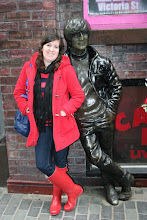Unless
you’ve been living under a rock somewhere, you’re likely aware by now that London is
currently hosting the 2012 Olympic and Paralympic Games. I mean, even the last
country on earth to get television (Bhutan in 1999) brought a team for the
archery, so this thing kind of has a global reach. And, during last night’s
spectacular Opening Ceremonies, there were nations I had never even heard of
(Comoros, Kiribati, Palau), so you can bet that televisions were on in even the
most remote islands dotted around the Pacific.
The five
Olympic rings represent the five continents – Africa, Asia, the Americas,
Europe and Oceania – and 204 nations are expected to be represented. And that,
to me, is what makes the Olympics so awe-inspiring; the sense of nationalistic
pride and, if only temporarily, a little global unity. Countries like
Afghanistan and Libya have brought teams, which gives me a bit of hope around
peaceful coexistence and, at least for a few weeks, a shared common goal.
I know not
everyone gives a shit. I mean, I’m not really that bothered about the actual
sport (if it was the Winter Olympics, I’d be a bit more into the actual events).
And I’m aware of the contradictions evident in the fact that war-torn countries
are attending this billion-pound extravaganza, while civilians back home are
struggling for food, water and a day without guaranteed safety. There is also
the exorbitant costs (which I do prefer not to think about), but you would do
well to keep in mind that Beijing spent $300 million on its Opening Ceremonies
in 2008, so London’s £27 million for last night’s impressive display barely
registers.
From my,
admittedly, very cushy vantage point, it sure is interesting to watch my city
turn into host, something that’s been coming for seven years. Long before I
even dreamed of moving here, a bid headed by former Olympic champion Sebastian
Coe and then mayor Ken Livingstone in July 2005 was selected. It makes London
the first city to officially host the modern Olympic Games three times, having
previously done so in 1908 and 1948. And it has been truly amazing to watch the
preparations unfold over the past three years, all culminating in the next few
weeks of sport and cultural events around London.
So, let’s
get into the Opening Ceremonies. While I was watching, I did wonder whether
much of what was happening at the Olympic Stadium last night made any sense to
the rest of the world. Honestly, if I hadn’t been living here for the past
three years, soaking up British idiosyncrasies on a daily basis, a lot of it
would have gone right over my head. But I think that’s kind of the point of the
Opening Ceremonies; to showcase the host nation in all its historical and
cultural contexts, demonstrating to the rest of the world what makes the UK
unique.
The
presence of the Chelsea pensioners, Pearly kings and queens, subtle soundbites
from East Enders and The Archers, a performance by local rap star Dizzie
Rascal, and the entire segment celebrating the National Health Service (NHS)
would have meant nothing to be three years ago. But I think the bits with Queen
E and James Bond, Mr Bean’s accompaniment of the London Symphony Orchestra, the
children’s choirs in England, Scotland, Wales and Northern Ireland, and the
shout-out to British film, music and literature, are generally known around the
world.
While I
thought the whole ceremony was phenomenal, there were three parts that I truly
loved. The entire first segment, which traced British history from a tableau of
rural English life in the 18th century, through to the vast chimneys and
steelworkers of the Industrial Revolution, then to a moment of silence for the
World Wars, onwards to the transformative, Beatles-driven 1960s (complete with
a queue of Sgt Peppers), and closing with the five iconic rings rising into the
pitch-black, cloudy London sky, was an inventive timeline that displayed why
its creator Danny Boyle (Trainspotting, 28 Days Later, Slumdog Millionaire) is
one of the greatest directors around.
I also
loved the incandescent insects that circled the track on bicycles later in the
show, glowing against the darkness of the stadium. And, at the end, when five
past Olympic heroes literally passed the flame to five of the next generation
of British athletes, I couldn’t help but feel a little emotional. The cauldron,
a complex structure of 204 moving steel rods and copper petal-like elements
representing the nations taking part in the Games, was probably the absolute
highlight for me. It was stunning to see the fiery rods slowly rise into the
sky to unite in one flame. A fitting analogy for the whole concept of the
Olympics. Then the fireworks, exploding in the sky in East London, which we could hear from home in Islington.
It has all
made me feel a bit sad that I didn’t get involved much in the last Winter
Olympics, when Vancouver hosted the world (I was already living here, after
all). But I am thrilled to be an adopted Briton this time around. The world is
watching, and I will be able to one day tell my grandchildren that I had a front-row
seat.

